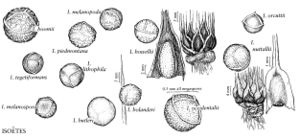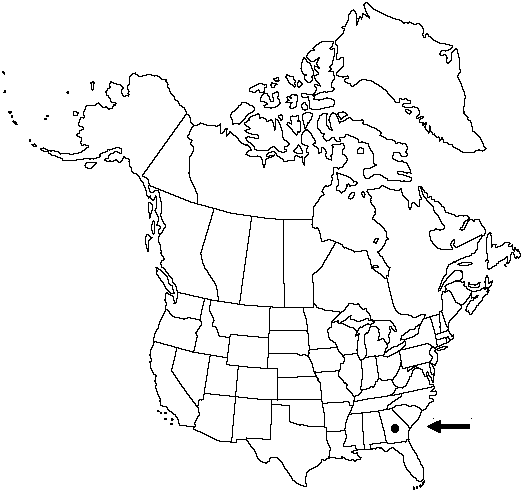Difference between revisions of "Isoëtes boomii"
Amer. Fern. J. 82: 23. 1992.
FNA>Volume Importer |
imported>Volume Importer |
||
| (7 intermediate revisions by 2 users not shown) | |||
| Line 17: | Line 17: | ||
}}<!-- | }}<!-- | ||
| − | --><span class="statement" id="st- | + | --><span class="statement" id="st-undefined" data-properties=""><b>Plants </b>aquatic, emergent. <b>Rootstock</b> nearly globose, 2-lobed. <b>Leaves</b> deciduous, bright green, pale toward base, spirally arranged, to 45 cm, pliant gradually tapering toward tip. <b>Velum</b> covering less than 1/2 sporangium. <b>Sporangium</b> wall ± brown-streaked. <b>Megaspores</b> white, 460–610 μm diam., cristate to reticulate with thin ridges; girdle obscure. <b>Microspores</b> light gray in mass, 35–30 μm, papillose. <b>2n</b> = 66.</span><!-- |
-->{{Treatment/Body | -->{{Treatment/Body | ||
| + | |phenology=Spores mature in late summer. | ||
|habitat=Flowering water in low woods | |habitat=Flowering water in low woods | ||
|distribution=Ga. | |distribution=Ga. | ||
| − | |discussion=<p>Isoëtes boomii is known only from low, wet woods in Laurens County, Georgia. Early collections bearing only microspores were identified as I. flaccida. These were reported as I. flaccida x piedmontana and as having a velum coverage of 70–90% (B. M. Boom 1982), but recent collections have a velum coverage of less than 50%. The megaspore texture of broken lamellae and a narrow velum coverage do not indicate an I. flaccida influence.</p><!-- | + | |discussion=<p><i>Isoëtes boomii</i> is known only from low, wet woods in Laurens County, Georgia. Early collections bearing only microspores were identified as <i>I. flaccida</i>. These were reported as <i>I. flaccida</i> x piedmontana and as having a velum coverage of 70–90% (B. M. Boom 1982), but recent collections have a velum coverage of less than 50%. The megaspore texture of broken lamellae and a narrow velum coverage do not indicate an <i>I. flaccida</i> influence.</p><!-- |
--><p>Of conservation concern.</p> | --><p>Of conservation concern.</p> | ||
|tables= | |tables= | ||
| Line 32: | Line 33: | ||
-->{{#Taxon: | -->{{#Taxon: | ||
name=Isoëtes boomii | name=Isoëtes boomii | ||
| − | |||
|authority=Luebke | |authority=Luebke | ||
|rank=species | |rank=species | ||
| Line 39: | Line 39: | ||
|basionyms= | |basionyms= | ||
|family=Isoëtaceae | |family=Isoëtaceae | ||
| + | |phenology=Spores mature in late summer. | ||
|habitat=Flowering water in low woods | |habitat=Flowering water in low woods | ||
|distribution=Ga. | |distribution=Ga. | ||
| Line 45: | Line 46: | ||
|publication year=1992 | |publication year=1992 | ||
|special status= | |special status= | ||
| − | |source xml=https:// | + | |source xml=https://bitbucket.org/aafc-mbb/fna-data-curation/src/2e0870ddd59836b60bcf96646a41e87ea5a5943a/coarse_grained_fna_xml/V2/V2_747.xml |
|genus=Isoëtes | |genus=Isoëtes | ||
|species=Isoëtes boomii | |species=Isoëtes boomii | ||
| − | |||
| − | |||
| − | |||
| − | |||
| − | |||
| − | |||
| − | |||
| − | |||
| − | |||
| − | |||
| − | |||
| − | |||
| − | |||
| − | |||
| − | |||
| − | |||
| − | |||
| − | |||
| − | |||
| − | |||
| − | |||
}}<!-- | }}<!-- | ||
-->[[Category:Treatment]][[Category:Isoëtes]] | -->[[Category:Treatment]][[Category:Isoëtes]] | ||
Latest revision as of 20:25, 5 November 2020
Plants aquatic, emergent. Rootstock nearly globose, 2-lobed. Leaves deciduous, bright green, pale toward base, spirally arranged, to 45 cm, pliant gradually tapering toward tip. Velum covering less than 1/2 sporangium. Sporangium wall ± brown-streaked. Megaspores white, 460–610 μm diam., cristate to reticulate with thin ridges; girdle obscure. Microspores light gray in mass, 35–30 μm, papillose. 2n = 66.
Phenology: Spores mature in late summer.
Habitat: Flowering water in low woods
Discussion
Isoëtes boomii is known only from low, wet woods in Laurens County, Georgia. Early collections bearing only microspores were identified as I. flaccida. These were reported as I. flaccida x piedmontana and as having a velum coverage of 70–90% (B. M. Boom 1982), but recent collections have a velum coverage of less than 50%. The megaspore texture of broken lamellae and a narrow velum coverage do not indicate an I. flaccida influence.
Of conservation concern.
Selected References
None.

